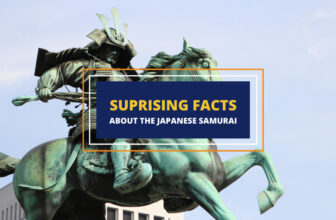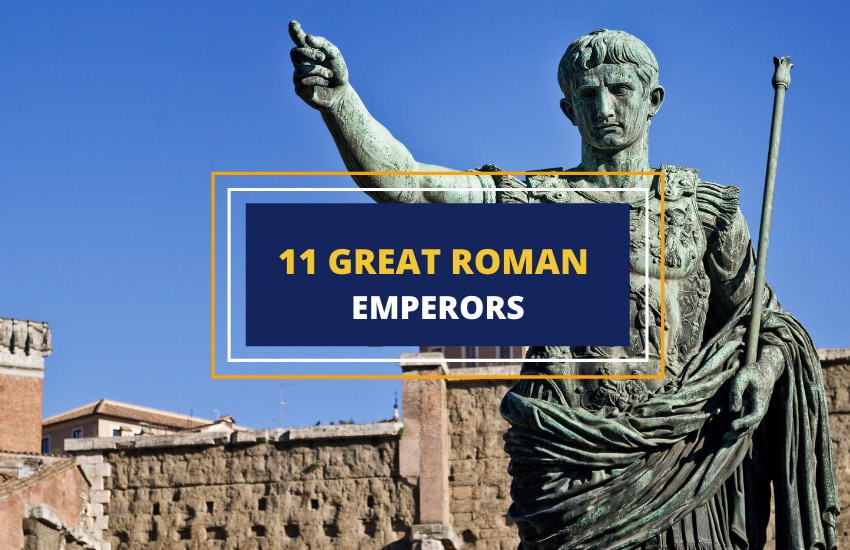
Table of Contents
The Roman Republic survived for several centuries before the decline of its institutions gave rise to the Roman Empire. In ancient Roman history, the imperial period begins with the ascension of Augustus, Caesar’s heir, to power in 27 BC, and ends with the fall of the Western Roman Empire into the hands of the ‘barbarians’ in 476 AD.
The Roman Empire laid the basis for the foundation of Western Civilization, but many of its achievements wouldn’t have been possible without the work of a group of selected Roman emperors. These leaders were often ruthless, but they also used their unlimited power to bring stability and welfare to the Roman state.
This article lists 11 Roman emperors from the late first century BC until the sixth century AD, who greatly influenced Roman history.
Augustus (63 BC-14 AD)
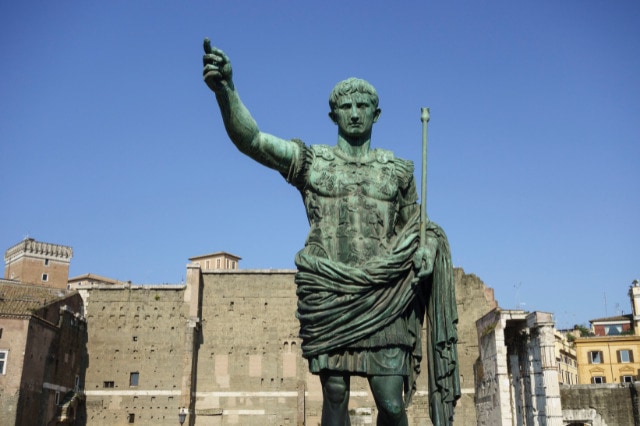
Augustus (27 BC-14 AD), the first Roman emperor, had to overcome many challenges to hold that position.
After Caesar’s assassination in 44 BC, many Romans thought that Mark Anthony, a former chief lieutenant of Caesar’s, would become his heir. But instead, in his will, Caesar adopted Augustus, one of his grandnephews. Augustus, who was only 18 at the time, behaved as a grateful heir. He joined forces with Mark Anthony, despite knowing that the powerful commander perceived him as an enemy, and declared war on Brutus and Cassius, the main plotters behind Caesar’s murder. By that time, the two assassins had taken control over the Eastern Roman provinces of Macedonia and Syria.
The forces of the two parties clashed in the Battle of Philippi, in 42 BC, where Brutus and Cassius were defeated. Then, the winners distributed the Roman territories between them and Lepidus, a former Caesar supporter. The ‘triumvirs’ were supposed to govern together until the constitutional order of the fading Republic was restored, but eventually they started to plot against each other.
Augustus knew that among the triumvirs, he was the least experienced strategist, so he appointed Marcus Agrippa, an outstanding admiral, as the commander of his troops. He also waited for his counterparts to do the first move. In 36 BC, Lepidus’ forces tried to conquer Sicily (which was supposed to be neutral ground), but were successfully defeated by the Augustus-Agrippa contingent.
Five years later, Augustus convinced the Senate to declare war on Cleopatra. Mark Antony, who was the Egyptian queen’s lover at the time, decided to support her, but even fighting with combined armies, they both were defeated at the Battle of Actium, in 31 BC.
Finally, in 27 BC Augustus became emperor. But, despite being an autocrat, Augustus preferred to avoid holding titles such as ‘rex’ (Latin word for ‘king’) or ‘dictator perpetuus’, knowing that the republican Roman politicians were extremely wary about the idea of having a monarchy. Instead, he adopted the title of ‘princeps’, which meant ‘the first citizen’ among the Romans. As an emperor, Augustus was scrupulous and methodical. He reorganized the state, conducting censuses, and reforming the administrative apparatus of the empire.
Tiberius (42 BC-37 AD)
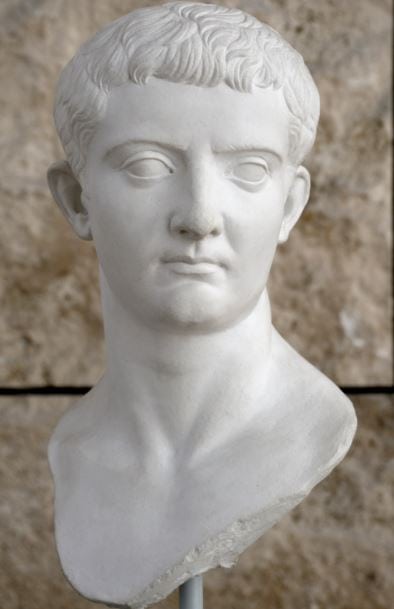
Tiberius (14 AD-37 AD) became the second emperor of Rome after the death of Augustus, his stepfather. The reign of Tiberius can be divided into two parts, with the year 26 AD marking a turning point.
During his early rule, Tiberius re-established Roman control over the territories of Cisalpine Gaul (modern-day France) and the Balkans, thus securing the Northern frontier of the empire for many years. Tiberius also temporarily conquered parts of Germania but was cautious not to get involved in any extended military conflict, as Augustus had indicated to him. The empire’s economy also enjoyed significant growth as a consequence of this period of relative peace.
The second half of Tiberius’ reign is marked with a series of family tragedies (the first being the death of his son Drusus in 23 AD), and the emperor’s permanent withdrawal from politics in 27 AD. During the last decade of his life, Tiberius ruled the empire from a private villa in Capri, but he made the mistake of leaving Sejanus, one of his high magistrates, in charge of executing his orders.
In the absence of Tiberius, Sejanus used the Praetorian Guard (a special military unit created by Augustus, whose purpose was to protect the emperor) to persecute his own political adversaries. Eventually, Tiberius got rid of Sejanus, but the reputation of the emperor suffered severely from the actions of his subordinate.
Claudius (10 AD-54 AD)
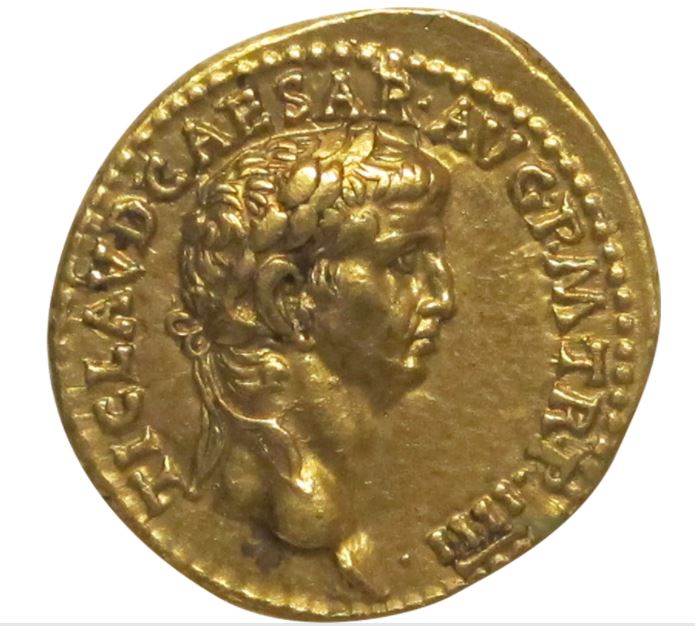
After Caligula was slaughtered by his imperial guard, both the Praetorians and the Senate started looking for a manipulable, docile man to fill the role of the emperor; they found it in Caligula’s uncle, Claudius (41 AD-54 AD).
During his childhood, Claudius was afflicted with an undiagnosed disease that left him with several disabilities and tics: he stuttered, had a limp, and was slightly deaf. While many underestimated him, Claudius unexpectedly turned out to be a very efficient ruler.
Claudius first secured his position on the throne by rewarding the Praetorian troops, who had been loyal to him, with cash. Soon after, the emperor organized a cabinet, composed mainly of freed men, in an attempt to undermine the power of the Senate.
During Claudius’ reign, the provinces of Lycia and Thrace were annexed to the Roman Empire. Claudius also ordered, and briefly commanded, a military campaign to subjugate Britannia (modern-day Britain). A significant portion of the island was conquered by 44 BC.
The emperor also undertook many public works. For instance, he had several lakes drained, which provided the empire with more cultivable land, and he also constructed two aqueducts. Claudius died in 54 AD and was succeeded by his adoptive son, Nero.
Vespasian (9 AD-79 AD)
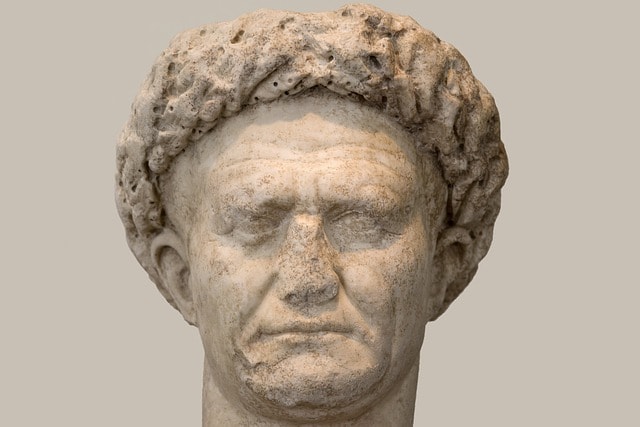
Vespasian was the first Roman emperor (69 AD-79 AD) of the Flavian dynasty. From humble origins, he progressively accumulated power due to his military achievements as a commander.
In 68 AD, when Nero died, Vespasian was proclaimed emperor by his troops in Alexandria, where he was stationed at the time. However, Vespasian was only officially ratified as princeps one year later by the Senate, and by then he had to put up with a series of provincial revolts, left unattended by the Nero administration.
To deal with this situation, Vespasian first restored the discipline of the Roman army. Soon, all the insurgents were defeated. Nevertheless, the emperor ordered the troops stationed in the eastern provinces to be tripled; a measure motivated by the fierce Jewish revolt in Judea that lasted from 66 AD to 70 AD, and ended only with the Siege of Jerusalem.
Vespasian also considerably increased public funds, by the institution of new taxes. These revenues were later used to finance a building restoration program in Rome. It was during this period that the construction of the Colosseum began.
Trajan (53 AD-117 AD)
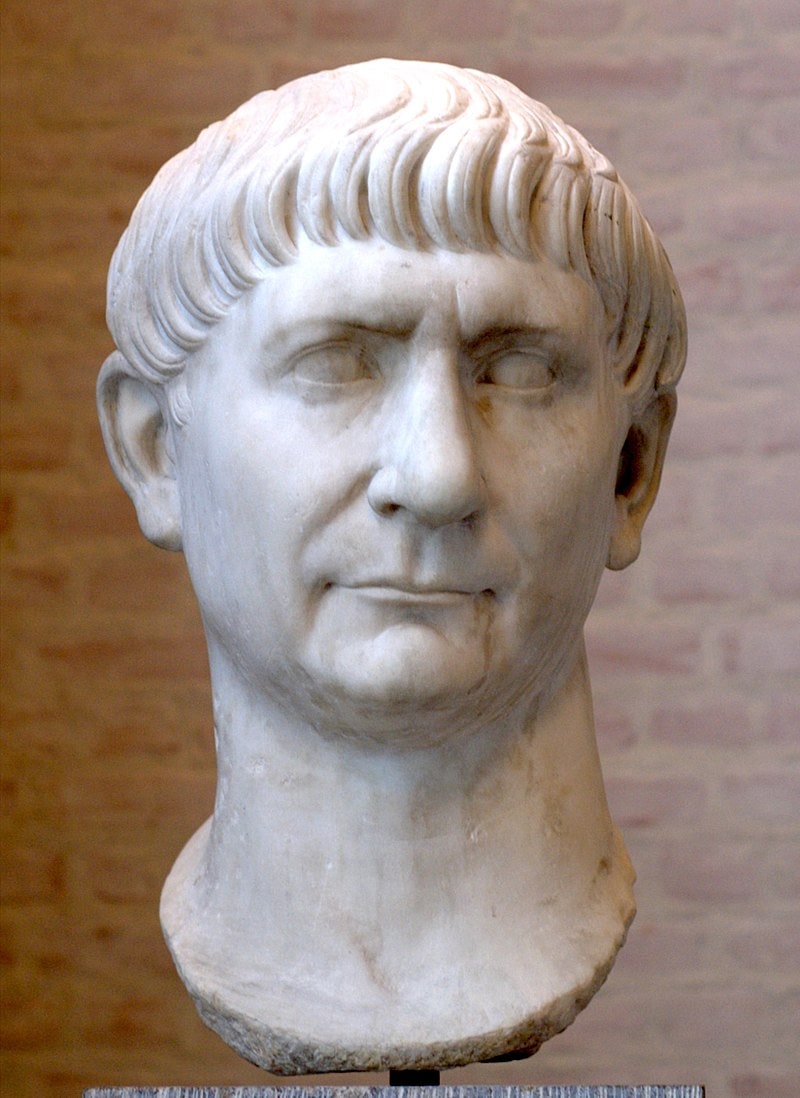
Trajan (98 AD-117 AD) is considered to be one of the greatest rulers of the imperial period, due to his ability as a commander and his interest in protecting the poor. Trajan was adopted by the emperor Nerva, and became the next princeps when the latter died.
During Trajan’s rule, the Roman Empire conquered Dacia (located in modern Romania), which became a Roman province. Trajan also led a large military campaign in Asia Minor, and marched further into the east, defeating the forces of the Parthian Empire, and capturing parts of Arabia, Armenia, and Upper Mesopotamia.
To improve the living conditions of poor citizens of the empire, Trajan lessened different kinds of taxes. The emperor also implemented the ‘alimenta’, a public fund destined to cover the expenses of the feeding of poor children from Italian cities.
Trajan died in 117 AD and was succeeded by his cousin Hadrian.
Hadrian (76 AD-138 AD)
Hadrian (117 AD-138 AD) became known for being a restless emperor. During his rule, Hadrian traveled many times across the empire, overseeing the state of the troops to make sure they met his rigorous standards. These inspections helped to secure the borders of the Roman Empire for almost 20 years.
In Roman Britain, the borders of the empire were reinforced with a 73 miles long wall, commonly known as Hadrian’s Wall. The construction of the famous wall started in 122 AD and by 128 AD most of its structure was already finished.

Emperor Hadrian was very fond of Greek culture. Historical evidence suggests that he traveled to Athens at least three times during his rule, and also became the second Roman emperor to be initiated in the Eleusinian Mysteries (with Augustus being the first).
Hadrian died in 138 AD and was succeeded by his adoptive son, Antoninus Pius.
Antoninus Pius (86 AD-161 AD)
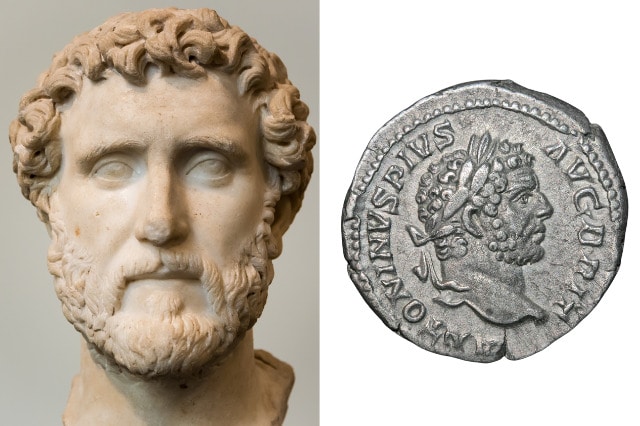
Unlike most of his predecessors, Antoninus (138 AD-161 AD) didn’t command any Roman army into the battlefield, a notable exception, probably caused by the fact that there were no significant uprisings against the empire during his rule. These peaceful times allowed the Roman emperor to promote arts and sciences, and to build aqueducts, bridges, and roads all over the empire.
Despite Antoninus’ apparent policy of not altering the borders of the empire, the suppression of a minor rebellion at Roman Britain allowed the emperor to annex the territory of southern Scotland to his dominions. This new frontier was reinforced with the construction of a 37 miles long wall, later known as the Antoninus’ wall.
Why the Senate granted Antoninus the title of ‘Pius’ is still a matter of discussion. Some scholars suggest that the emperor acquired this cognomen after sparing the life of some senators that Hadrian had sentenced to death just before dying.
Other historians think that the surname is a reference to the perpetual loyalty that Antoninus showed to his predecessor. Indeed, it was thanks to Antoninus’ diligent requests that the Senate, though reluctantly, finally agreed to deify Hadrian.
Marcus Aurelius (121 AD-180 AD)
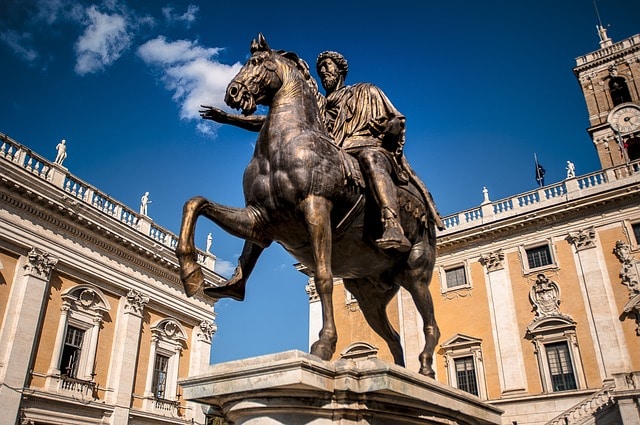
Marcus Aurelius (161 AD-180 AD) succeeded Antoninus Pius, his adoptive father. From an early age and throughout his rule, Aurelius practiced the principles of Stoicism, a philosophy that compels men to pursue a virtuous life. But, despite Aurelius’ contemplative nature, the many military conflicts that took place during his reign made this period one of the most turbulent in the history of Rome.
Little after Aurelius had taken office, the Parthian Empire invaded Armenia, an important ally kingdom of Rome. In response, the emperor sent a group of versed commanders to lead the Roman counterattack. It took the imperial forces four years (162 AD-166 AD) to repel the invaders, and when the victorious legions came back from the east, they brought home a virus that killed millions of Romans.
With Rome still dealing with the plague, in late 166 AD a new threat appeared: a series of invasions of Germanic tribes that began to raid several Roman provinces located west to the rivers Rhine and Danube. The lack of manpower forced the emperor to levy recruits from among the slaves and gladiators. Moreover, Aurelius himself decided to command his troops on this occasion, despite having no military experience.
The Marcomannic Wars lasted until 180 AD; during this time the emperor wrote one of the most famous philosophical works of the ancient world, the Meditations. This book gathers Marcus Aurelius’ reflections on different topics, from his insights on war to various dissertations on how men can achieve virtue.
Diocletian (244 AD-311 AD)
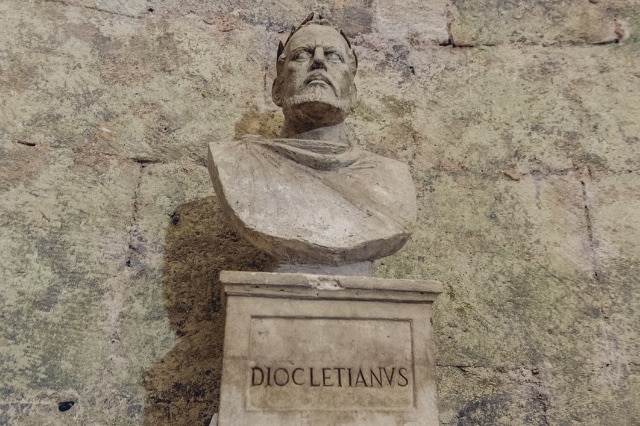
With the ascension of Commodus (Marcus Aurelius’ heir) to the throne in 180 AD, a long period of political unrest for Rome began, one that lasted until the arrival of Diocletian (284 AD-305 AD) to power. Diocletian instituted a series of political reforms that allowed the Roman Empire to survive for almost two centuries in the West and many more in the East.
Diocletian realized that the empire had become too big to be efficiently protected by only one sovereign, so in 286 AD he appointed Maximian, a former colleague in arms of him, as co-emperor, and virtually split the Roman territory into two halves. From this point forward, Maximian and Diocletian would respectively defend the Western and Eastern parts of the Roman Empire. During this reorganization, Milan and Nicomedia were designated as the new administrative centers of the empire; depriving Rome (the city) and the Senate of its former political preeminence.
The emperor also reorganized the army, relocating most of its heavy infantry across the borders of the empire, to increase its defensibility. Diocletian accompanied the last measure with the building of many fortresses and forts across the empire.
The fact that Diocletian replaced the imperial title of ‘princeps’or ‘first citizen’ for that of ‘dominus’, which means ‘master’ or ‘owner’, indicates just how much the role of the emperor could be homologated with that of an autocrat during this period. However, Diocletian voluntarily abdicated from his powers after having ruled for 20 years.
Constantine I (312 AD-337 AD)
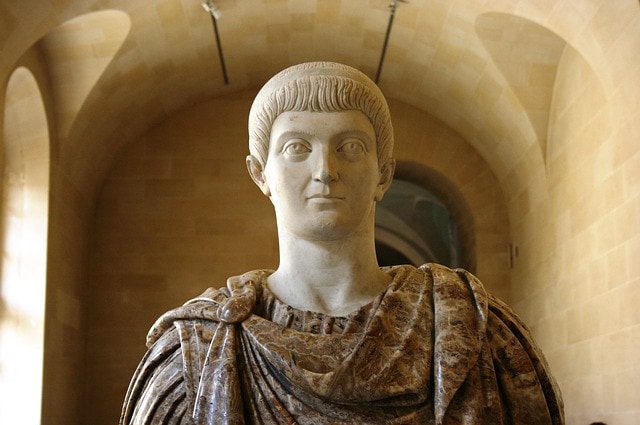
By the time the emperor Diocletian retired, the diarchy that he had instituted had already evolved into a tetrarchy. Eventually, this system of four rulers proved to be inefficient, given the tendency of the co-emperors to declare war on each other. It’s in this political context that the figure of Constantine I (312 AD-337 AD) appeared.
Constantine was the Roman emperor that converted Rome to Christianity and recognize the Christian faith as an official religion. He did so after having seen a flaming cross in the sky, while hearing the Latin words “In hoc signos vinces”, which means “In this sign you shall conquer”. Constantine had this vision when he was marching to the Battle of the Milvian Bridge in 312 AD, a decisive encounter that made him the sole ruler of the Western section of the empire.
In 324 AD, Constantine marched East and defeated Licinius, his co-emperor, in the Battle of Chrysopolis, thus completing the reunification of the Roman Empire. This is usually considered the most important of Constantine’s accomplishments.
However, the emperor didn’t restore Rome as the capital of the empire. Instead, he chose to rule from Byzantium (renamed ‘Constantinople’ after him in 330 AD), a well-fortified city from the East. This change was probably motivated by the fact that the West had increasingly become more and more difficult to protect from barbaric invasions over time.
Justinian (482 AD-565 AD)
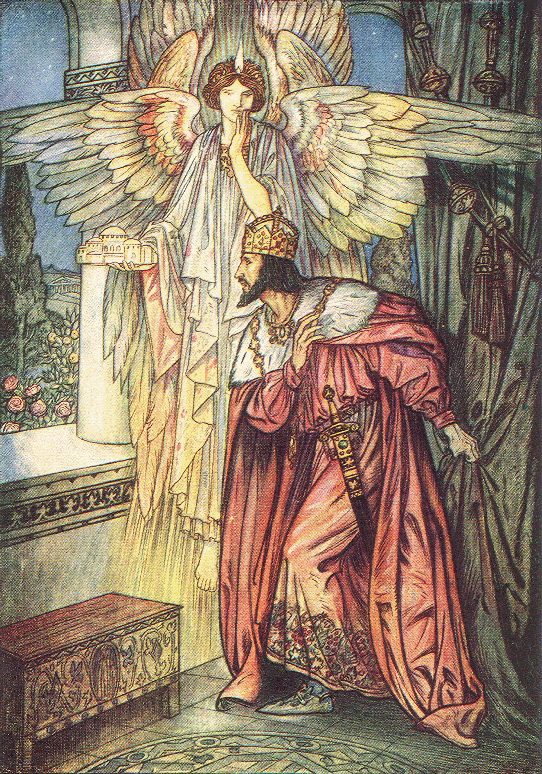
The Western Roman Empire fell in the hands of the barbarians by 476 AD. In the Eastern half of the empire, such loss was resented but the imperial forces couldn’t do anything, since they were vastly outnumbered. However, in the next century Justinian (527 AD-565 AD) would undertake the task of restoring the Roman Empire to its former glory, and partly succeeded.
Justinian’s generals led many successful military campaigns in Western Europe, eventually taking back from the barbarian lots of former Roman territories. All the Italian peninsula, Northern Africa, and the new province of Spania (South of modern Spain) were annexed to the Roman Eastern Empire during Justinian’s rule.
Unfortunately, the Western Roman territories would be lost again within a few years after Justinian’s death.
The emperor also ordered the reorganization of Roman law, an effort that resulted in the Justinian code. Justinian is often considered to be simultaneously the last Roman emperor and the first ruler of the Byzantine Empire. The latter would be responsible for carrying the legacy of the Roman world into the Middle Ages.
Conclusion
From the Romance languages to the foundation of modern law, many of the most important cultural achievements of the Western Civilization were only possible thanks to the development of the Roman Empire and the work of its leaders. This is why knowing the accomplishments of the greater Roman emperors is so important to have a better understanding of both the past and the present world.





